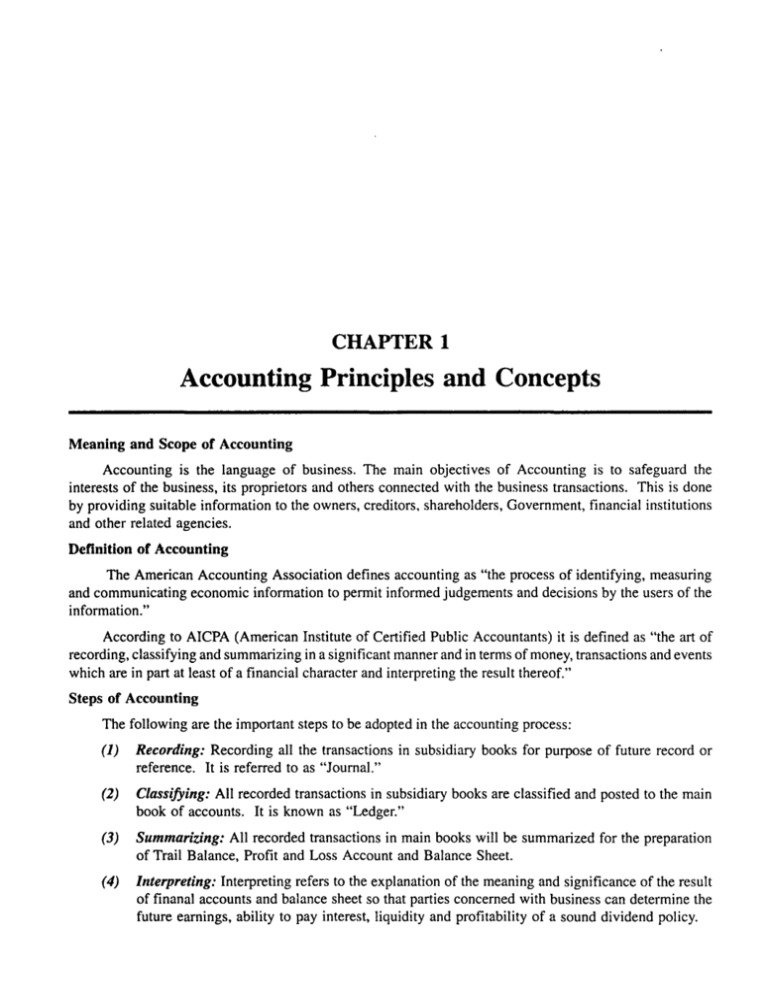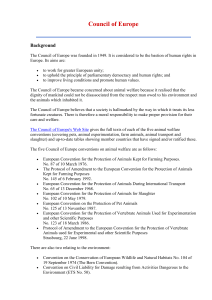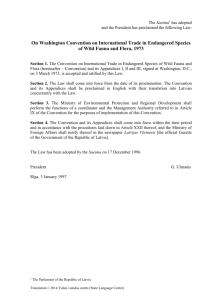CHAPTER 1 Accounting Principles and Concepts
advertisement

CHAPTER 1 Accounting Principles and Concepts Meaning and Scope of Accounting Accounting is the language of business. The main objectives of Accounting is to safeguard the interests of the business, its proprietors and others connected with the business transactions. This is done by providing suitable information to the owners, creditors, shareholders, Government, financial institutions and other related agencies. Definition of Accounting The American Accounting Association defines accounting as "the process of identifying, measuring and communicating economic information to permit informed judgements and decisions by the users of the information." According to AICPA (American Institute of Certified Public Accountants) it is defined as "the art of recording, classifying and summarizing in a significant manner and in terms of money, transactions and events which are in part at least of a financial character and interpreting the result thereof." Steps of Accounting The following are the important steps to be adopted in the accounting process: (1) Recording: Recording all the transactions in subsidiary books for purpose of future record or reference. It is referred to as "Journal." (2) Classifying: All recorded transactions in subsidiary books are classified and posted to the main book of accounts. It is known as "Ledger." (3) Summarizing: All recorded transactions in main books will be summarized for the preparation of Trail Balance, Profit and Loss Account and Balance Sheet. (4) Interpreting: Interpreting refers to the explanation of the meaning and significance of the result of finanal accounts and balance sheet so that parties concerned with business can determine the future earnings, ability to pay interest, liquidity and profitability of a sound dividend policy. 2 A Textbook of Financial Cost and Management Accounting Functions of Accounting From the definition and analysis of the above the main functions of accounting can be summarized as: (1) Keeping systematic record of business transactions. (2) Protecting properties of the business. (3) Communicating the results to various parties interested in or connected with the business. (4) Meeting legal requirements. Objectives of Accounting (1) Providing suitable information with an aim of safeguarding the interest of the business and its proprietors and others connected with it. (2) To emphasis on the ascertainment and exhibition of profits earned or losses incurred in the business. (3) To ascertain the financial position of the business as a whole. (4) To ensure accounts are prepared according to some accepted accounting concepts and conventions. (5) To comply with the requirements of the Companies Act, Income Tax Act, etc. Definition of Bookkeeping Bookkeeping may be defined as "the art of recording the business transactions in the books of accounts in a systematic manner." A person who is responsible for and who maintains and keeps a record of the business transactions is known as Bookkeeper. His work is primarily clerical in nature. On the other hand, Accounting is primarily concerned with the recording, classifying, summarizing, interpreting the financial data and communicating the information disclosed by the accounting records to those persons interested in the accounting information relating to the business. Limitations of Accounting (1) Accounting provides only limited information because it reveals the profitability of the concern as a whole. (2) Accounting considers only those transactions which can be measured in terms of money or quantitatively expressed. Qualitative information is not taken into account. (3) Accounting provides limited information to the management. (4) Accounting is only historical in nature. It provides only a post mortem record of business transactions. Branches of Accounting The main function of accounting is to provide the required informations for different parties who are interested in the welfare of that enterprise concerned. In order to serve the needs of management and outsiders various new branches of accounting have been developed. The following are the main branches of accounting: (1) Financial Accounting. (2) Cost Accounting. (3) Management Accounting. Accounting Principles and Concepts 3 (1) Financial Accounting: Financial Accounting is prepared to determine profitability and financial position of a concern for a specific period of time. (2) Cost Accounting: Cost Accounting is the formal accounting system setup for recording costs. It is a systematic procedure for determining the unit cost of output produced or service rendered. (3) Management Accounting: Management Accounting is concerned with presentation of accounting information to the management for effective decision making and control. Accounting Principles Various accounting systems and techniques are designed to meet the needs of the management. The information should be recorded and presented in such a way that management is able to arrive at right conclusions. The ultimate aim of the management is to increase profitability and losses. In order to achieve the objectives of the concern as a whole, it is essential to prepare the accounting statements in accordance with the generally accepted principles and procedures. The term principles refers to the rule of action or conduct to be applied in accounting. Accounting principles may be defined as "those rules of conduct or procedure which are adopted by the accountants universally, while recording the accounting transactions." The accounting principles can be classified into two categories: I. II. Accounting Concepts. Accounting Conventions. I. Accounting Concepts Accounting concepts mean and include necessary assumptions or postulates or ideas which are used to accounting practice and preparation of financial statements. The following are the important accounting concepts: (1) Entity Concept; (2) Dual Aspect Concept; (3) Accounting Period Concept; (4) Going Concern Concept; (5) Cost Concept; (6) Money Measurement Concept; (7) Matching Concept; (8) Realization Concept; (9) Accrual Concept; (10) Rupee Value Concept. II. Accounting Conventions Accounting Convention implies that those customs, methods and practices to be followed as a guideline for preparation of accounting statements. The accounting conventions can be classified as follows: (1) Convention of Disclosure. (2) Convention of Conservatism. A Textbook of Financial Cost and Management AccOlllllillg -I (3) Convention of Consistency. (4) Convention of Materiality. The following table summarizes classifications of Accounting Principles: Accounting Principles Accounting Concept Accounting Conventions (1) (2) (3) (4) (5) (6) Entity Concept Dual Aspect Concept Accounting Period Concept Going Concern Concept Cost Concept Money Measurement Concept (7) Matching Concept (8) Realization Concept (9) Accrual Concept (10) Rupee Value Concept (1) (2) (3) (4) Convention Convention Convention Convention of Disclosure of Conservatism of Consistency of Materiality The classification of accounting concepts and conventions can be explained in the following pages. I. Accounting Concepts (1) Entity Concept: Separate entity concept implies that business unit or a company is a body corporate and having a separate legal entity distinct from its proprietors. The proprietors or members are not liable for the acts of the company. But in the case of the partnership business or sole trader business no separate legal entity from its proprietors. Here proprietors or members are liable for the acts of the firm. As per the separate entity concept of accounting it applies to all forms of business to determine the scope of what is to be recorded or what is to be excluded from the business books. For example, if the proprietor of the business invests Rs.50,000 in his business, it is deemed that the proprietor has given that much amount to the business as loan which will be shown as a liability for the business. On withdrawal of any amount it will be debited in cash account and credited in proprietor's capital account. In conclusion, this separate entity concept applies much larger in body corporate sectors than sole traders and partnership firms. (2) Dual Aspect Concept: According to this concept, every business transaction involves two aspects, namely, for every receiving of benefit and. there is a corresponding giving of benefit. The dual aspect concept is the basis of the double entry book keeping. Accordingly for every debit there is an equal and corresponding credit. The accounting equation of the dual aspect concept is: Capital + Liabilities = Assets (or) Assets = Equities (Capital) The term Capital refers to funds provide by the proprietor of the business concern. On the other hand, the term liability denotes the funds provided by the creditors and debenture holders against the assets of the business. The term assets represents the resources owned by the business. For example, Mr.Thomas Starts business with cash of Rs.l ,00,000 and building of Rs.5,00,000, then this fact is recorded at two places; Assets Accounts and Capital Account. In other words, the business acquires assets of Rs.6,00,000 which is equal to the proprietor's capital in the form of cash of Rs.l,OO,OOO and building worth of Rs.5,00,000. The above relationship can be shown in the form of accounting equation: Capital + Liabilities Rs.l,OO,OOO + Rs.5,00,000 = = Assets Rs.6,OO,OOO Accounting Principles and Concepts 5 (3) Accounting Period Concept: According to this concept, income or loss of a business can be analysed and determined on the basis of suitable accounting period instead of wait for a long period, Le., until it is liquidated. Being a business in continuous affairs for an indefinite period of time, the proprietors, the shareholders and outsiders want to know the financial position of the concern, periodically. Thus, the accounting period is normally adopted for one year. At the end of the each accounting period an income statement and balance sheet are prepared. This concept is simply intended for a periodical ascertainment and reporting the true and fair financial position of the concern as a whole. (4) Going Concern Concept: It is otherwise known as Continue of Activity Concept. This concept assumes that business concern will continue for a long period to exit. In other w.ords, under this assumption, the enterprise is normally viewed as a going concern and it is not likely to be liquidated in the near future. This assumption implies that while valuing the assets of the business on the basis of productivity and not on the basis of their realizable value or the present market value, at cost less depreciation till date for the purpose of balance sheet. It is useful in valuation of assets and liabilities, depreciation of fixed assets and treatment of prepaid expenses. (5) Cost Concept: This concept is based on "Going Concern Concept." Cost Concept implies that assets acquired are recorded in the accounting books at the cost or price paid to acquire it. And this cost is the basis for subsequent accounting for the asset. For accounting purpose the market value of assets are not taken into account either for valuation or charging depreciation of such assets. Cost Concept has the advantage of bringing objectivity in the preparation and presentation of financial statements. In the absence of cost concept, figures shown in accounting records would be subjective and questionable. But due to inflationary tendencies, the preparation of financial statements on the basis of cost concept has become irrelevant for judging the true financial position of the business. (6) Money Measurement Concept: According to this concept, accounting transactions are measured, expressed and recorded in terms of money. This concept excludes those transactions or events which cannot be expressed in terms of money. For example, factors such as the skill of the supervisor, product policies, planning, employer-employee relationship cannot be recorded in accounts in spite of their importance to the business. This makes the financial statements incomplete. (7) Matching Concept: Matching Concept is closely related to accounting period concept. The chief aim of the business concern is to ascertain the profit periodically. To measure the profit for a particular period it is essential to match accurately the costs associated with the revenue. Thus, matching of costs and revenues related to a particular period is called as Matching Concept. (8) Realization Concept: Realization Concept is otherwise known as Revenue Recognition Concept. According to this concept, revenue is the gross inflow of cash, receivables or other considerations arising in the course of an enterprise from the sale of goods or rendering of services from the holding of assets. If no sale takes place, no revenue is considered. However, there are certain exceptions to this concept. Examples, Hire Purchase / Sale, Contract Accounts etc. (9) Accrual Concept: Accrual Concept is closely related to Matching Concept. According to this concept, revenue recognition depends on its realization and not accrual receipt. Likewise cost are recognized when they are incurred and not when paid. The accrual concept ensures that the profit or loss shown is on the basis of full fact relating to all expenses and incomes. (10) Rupee Value Concept: This concept assumes that the value of rupee is constant. In fact, due to inflationary pressures, the value of rupee will be declining. Under this situations financial statements are prepared on the basis of historical costs not considering the declining value of rupee. Similarly depreciation is also charged on the basis of cost price. Thus, this concept results in underestimation of depreciation and overestimation of assets in the balance sheet and hence will not reflect the true position of the business. 6 A Textbook of Financial Cost and Management Accounting II. Accounting Conventions (1) Convention of Disclosure: The disclosure of all material information is one of the important accounting conventions. According to this conventions all accounting statements should be honestly prepared and all facts and figures must be disclosed therein. The disclosure of financial informations are required for different parties who are interested in the welfare of that enterprise. The Companies Act lays down the forms of Profit and Loss Account and Balance Sheet. Thus convention of disclosure is required to be kept as per the requirement of the Companies Act and Income Tax Act. (2) Convention of Conservatism: This convention is closely related to the policy of playing safe. This principle is" often described as "anticipate no profit, and provide for all possible losses." Thus, this convention emphasise that uncertainties and risks inherent in business transactions should be given proper consideration. For example, under this convention inventory is valued at cost price or market price whichever is lower. Similarly, bad and doubtful debts is made in the books before ascertaining the profit. (3) Convention of Consistency: The Convention of Consistency implies that accounting policies, procedures and methods should remain unchanged for preparation of financial statements from one period to another. Under this convention alternative improved accounting policies are also equally acceptable. In order to measure the operational efficiency of a concern, this convention allows a meaningful comparison in the performance of different period. (4) Convention of Materiality: According to Kohler's Dictionary of Accountants Materiality may be defined as "the characteristid attaching to a statement fact, or item whereby its disclosure or method of giving it expression would be likely to influence the judgment of a reasonable person." According to this convention consideration is given to all material events, insignificant details are ignored while preparing the profit and loss account and balance sheet. The evaluation and decision of material or immaterial depends upon the circumstances and lies at the discretion of the Accountant. QUESTIONS 1. 2. 3. 4. 5. 6. 7. 8. 9. 10. 11. 12. Define Accounting. Explain nature and scope of accounting. What are the important functions of accounting? What are the objectives of ac~ounting? Define bookkeeping. Briefly explain the basic accounting concept and conventions. What are the important classification of accounting concepts? Explain them briefly. Write short notes on : (a) Convention of Disclosure. (b) Convention of Conservatism. (c) Convention of Consistency. What do you understand by Dual Aspect Concept? Explain Going Concern Concept. Write short notes on: (a) Cost Concept. (b) Money Measurement Concept. (c) Accounting Period Concept. What are the limitations of Accounting? DOD






